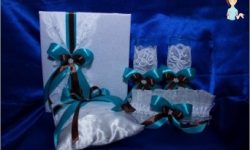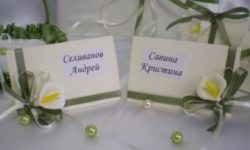Fabric flowers do it yourself
Flower Flower can be a real work of art, if the master will attach maximum effort to its creation. Master class will help master the initial stages
Flowers made of fabric, excellent accessory, use which can be for decorating your own hairstyle, summer dress, lambrequin. Elegant bouquet in the room Even in winter cold will create a unique warm atmosphere. Especially since making an elegant decoration is easy. Use for this can be used.
What do you need to create an accessory
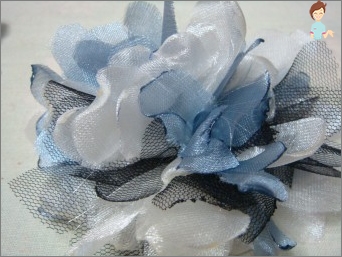 Deciding to perform a flower from the fabric better stocking of all the necessary tools, as well as materials in advance so that nothing distract from the creative process.
Deciding to perform a flower from the fabric better stocking of all the necessary tools, as well as materials in advance so that nothing distract from the creative process.
Be sure to:
- Trimming fabrics. You can use almost any material, different density and colors. But the optimal option is considered silk, fastetin, satin and velvet. Working with synthetic materials requires certain skills. Stretch does not hold a form, easily stretching;
- Paints. Well suited for fabric aniline dyes, ink, mascara, gouache, food dyes. As a rule, the need for paints occurs if the material palette is not enough wide. In the case of a large stock of the source material, it is not necessary to billet;
- Glue that dries quickly, not stinging material with dirty divorces. You can use your self-cooked Clauster flour, which is used to glue small parts and securing «Pollen». Good effect is obtained using dextrical glue, 1 st.L. which is diluted with a quarter of a glass of water and heated, mixing a little flour into a mixture. The best option is PVA glue;
- Wire for skes. It is advisable to take a wire depending on the size and weight of the accessory. Thin copper wire will bend under the weight of lush roses. Such a wire can be used for the manufacture of lungs, gentle colors. For heavy buds, aluminum wire is suitable;
- Wool is necessary to create a core of a flower or bouton filling. White material acquired in the pharmacy is painted independently in the desired tone;
- Paper will be required to charge stalks. As a rule, crepe decorative or cigarette paper of green and brown shades is applied;
- Threads Muline, Iris and others are needed for stamens, which are decorated with many flowers made of fabric;
- The semolina cereal, painted in different colors, will be required to create pollen on threaded stamens.
Prepare all materials, you can proceed to the creative process. First, it is better to try your hand in creating a simple accessory. If work is likely, soon the house will decorate wonderful bouquets.
Master class on the manufacture of flowers from fabric
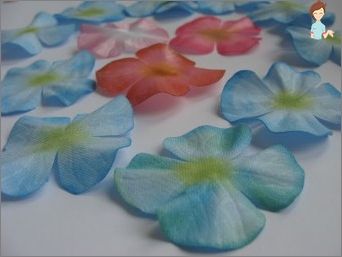 For the manufacture of a simple flower need to perform a round template for paper petals.
For the manufacture of a simple flower need to perform a round template for paper petals.
The diameter of the template and the number of blanks depend on the size and drawing of the accessory:
- For the medium-sized flower, it is enough to do 9 blanks. The pattern applies to the material and rub the marker. The resulting circles are neatly cut;
- Each circle needs to be cut over the midline. The obtained seafrodes are folded in half the inside of the tissue up and stitch the edges in a straight line, which bevented the side leaving free;
- Future petals turn so that the seam hides inside. Each billet will turn into a small cone. It is advisable to fold the workpieces so that the seam is in the middle;
- The open edge of the blanks are harvested on a thread and sweep. As a result, it turns out a neat petal. It is better to ride all the cones on the thread alternately and then dwell;
- Thread tightly tighten and tie, assess all the petals in one «beam». The central part of the flower can be decorated with beads.
Create dandelions and lilies
Oshiving a simple job, you can start the manufacture of a flower from a fabric, which is almost impossible to distinguish from the present, for example, dandelion.
- Step 1. Artificial yellow silk wet PVS. When the material is completely dry, cut off the strip, with a thickness of about 2-2.5 cm. Over the entire length of the strip, cuts are made with the minimum possible step, leaving under the base of not more than 0.5 cm.
- Step 2. The end of the aluminum wire is closely dried with paper and begin to gently screw the base of the sliced strip on it, not forgetting to miss the layers with glue. Should carefully perform work so that the edge of the strip does not move.
- Step 3. If the finished whine seems too small, you can prepare and screw another strip of fabric. Under the base of the wreath around the wire, winding a small piece of wool, forming a cup of flower.
- Step 4. You can soak cotton glue and paint green. Can neatly puncture green cloth. To do this, cut round item with a toothed edge. In the central part, the mug cut the hole through which the fabric to the base of the flower. A cup is lubricated with glue and firmly pressed to the base of the bud.
- Step 5. From a fine tissue of green color, the leaves are cut on the pattern, which from the wrong side are glued with a tinted Liton. Wire tightly wrapped with a thin strip of paper painted in suitable color. Leaves stick to stalk.
Gathering several dandelions, they can be placed in a small basket, settling a little summer sun in their room.
An unusually elegant is a lily made from Foamiran. This material is used specifically to create colors. By texture it resembles porous rubber.
- Step 1. Make a template similar to lily petal. 6 blanks cut out of the fabric. Each petal is necessary to heat, applying to the surface of a hot iron or blowing a jet of hot air from a hair dryer. After thermal processing, the material will be much more supplied.
- Step 2. The heated petal makes the most similar to natural, spending on the central part of the billet with a knife and creating a deep vein. The base is carried out with less noticeable accommodation to the edges of the petal.
- Step 3. You can not be afraid to spoil the workpiece, as Foamiran is the material with which professionals work when creating colors. When repeated heating, the fabric will return to the original form, so you can fix minor shortcomings.
- Step 4. Next, the petal needs to be pulled out and stretch its edges so that they become waving. For better stretching petal can be heated again.
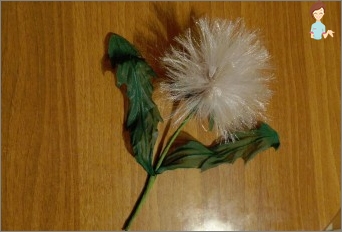 Step 5. Each petal to the back side is glued to a thin wire. Then the petals are covered with oil or acrylic paint, seeking similarity with the original. The base of the billets is stained with green tone, the central part is pink. Also in the middle part of the petal you can draw a few small specks characteristic of lily.
Step 5. Each petal to the back side is glued to a thin wire. Then the petals are covered with oil or acrylic paint, seeking similarity with the original. The base of the billets is stained with green tone, the central part is pink. Also in the middle part of the petal you can draw a few small specks characteristic of lily. - Step 6. From the threads whipped by Clauster, and the manets perform stamens. The ends of the thread after drying are simply dipped into the glue, and then into the semolina. Ready «pollen» Stained with yellow tone.
- Step 7. The flower is collected, trying to evenly distribute the petals and put in the middle of the stamens.
Elegant fabric flower, made independently, will be an excellent gift for a loved one or yourself, beloved. The main thing is not to dwell on the achieved, constantly improving the skill and inventing new, exotic versions of jewelry.

